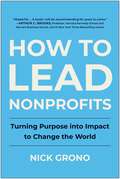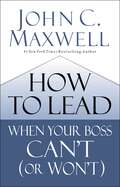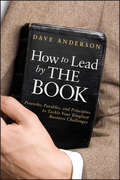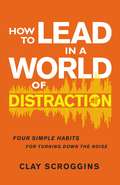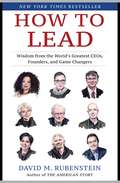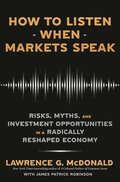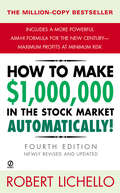- Table View
- List View
How to Kill the Scrum Monster: Quick Start to Agile Scrum Methodology and the Scrum Master Role
by Ilya BibikImplement Scrum or improve how Scrum works in your team or organization using this concise, sharp, and programmatic book. You will quickly learn what you need to know without getting confused with unnecessary details.What You'll LearnBecome familiar with Agile concepts and understand the path from Waterfall to the Agile ManifestoUnderstand the most commonly used Agile methodology—Scrum—and how it relates to eXtreme Programming and Kanban as well as to Lean principlesIdentify the challenges of the Scrum Master role and understand what this role is all aboutKnow the stages of Scrum team developmentEmbrace and solve conflicts in a Scrum teamWho This Book Is ForAnyone looking for a simple way to understand Scrum methodology
How to Knit Beautiful Bags: 22 Gorgeous Designs
by Sian BrownKnitted and crocheted accessories are totally on trend, and bags are particularly popular. They are relatively quick to make and knitters of all abilities can try new techniques that don’t take too long to complete. Sian has created 22 designs in a range of sizes and styles, suitable for beginners as well as more experienced knitters. They include colourwork, lace, cables and texture stitches, and are knitted using a variety of different yarns. All the bags are beautifully finished with coordinating fabric linings, pockets, and wadding to help them keep their shape, and are embellished with knitted flowers, buttons, bows and pompoms. There is a range of designs to choose from, including simple bags, totes, summer bags and evening bags, and the extensive techniques section at the back of the book provides step-by-step guidance on colourwork; embellishments such as surface embroidery, beads, knitted flowers and pompoms; making up and lining your bag; how to attach zips, buttons and other fastenings; and plaited cords and handles. Sian’s delightfully fresh and appealing designs and attention to detail make this an attractive book for all knitters.
How to Land a Top-Paying Federal Job: Your Complete Guide to Opportunities, Internships, Resumes and Cover Letters, Networking, Interviews, Salaries, Promotions, and More!
by Eleanor Holmes Norton Lily Madeleine WhitemanHow to Land a Top-Paying Federal Job is the ultimate guide to securing a government job, internship, or fellowship. Written by a successful career coach who has climbed the federal career ladder herself and served as a hiring manager, the book steers applicants through every stage of their job searchesùfrom finding unadvertised openings and getting interviews to sealing enviable deals and even get ting promoted. Drawing on interviews with more than 100 federal hiring managers, the book reveals the secrets to impressing these gatekeepers online, on paper, and in personùinformation that is available nowhere else. The updated second edition includes more get-ahead tips; new templates for writing winning applications; expanded directories for internships, fast-track management training programs and fellowships; and the latest helpful websites. Complete with a companion CD filled with sample rTsumTs, checklists, and templates, this indispensable book gives readers the inside scoop on landing some of the nationÆs most secure, well-paying, and rewarding jobsùin all 50 states and abroad!
How to Lead Nonprofits: Turning Purpose into Impact to Change the World
by Nick Grono&“Many go into nonprofit leadership unprepared for the twin demands of business management and measurable social impact. Finally, we have a resource that guides the way. Nick Grono&’s masterful How to Lead Nonprofits is a book I will be recommending for years to come.&” —Arthur C. Brooks, Professor, Harvard Kennedy School and Harvard Business School, and #1 New York Times Bestselling Author, Strength to Strength For nonprofit leaders who want to strengthen their leadership and increase the effectiveness of their organizations, a guide to achieving greater impact—featuring success stories from real nonprofit leaders Nonprofit leadership is hard. Most new nonprofit leaders are ill-prepared for the challenges they will face, and even those who are more experienced struggle to ensure their organizations deliver the change they are committed to. Nonprofits are not meant to be run like businesses—different incentives drive different priorities. In particular, nonprofit leaders have a key advantage over business leaders in that purpose is fundamental to their organization&’s work. From Nick Grono, CEO of the Freedom Fund and a nonprofit leader with decades of experience, How to Lead Nonprofits offers a leadership framework centered on what matters most for success: Achieving outsize impact by pursuing your organization's purpose Building an inclusive culture that motivates and empowers your team Partnering with the community you serve, funders, and peer organizations to scale impact With examples and testimony from nonprofit and charity leaders around the world, framed by Grono&’s own expertise, this is a highly usable guide to harnessing the power of purpose to shape everything your organization does—internally and externally—as you seek to change the world.
How to Lead When You're Not in Charge Study Guide: Leveraging Influence When You Lack Authority
by Clay ScrogginsThe greatest myth of leadership is that you must be in charge in order to lead.Great leaders aren't paralyzed by not being in a position of recognized authority. Great leaders lead with or without that authority and learn to unleash their positive influence wherever they are.In this six-session, video-based study (DVD/streaming video sold separately), dynamic author and pastor Clay Scroggins shares his first-hand experience working under Andy Stanley at North Point Community Church. He explains the nature of leadership and what it takes to lead yourself and others well with or without that impressive title.In this study you will:Learn to leverage influence instead of authorityCreate a game plan for leading yourself well Change the energy of your team by choosing positivityCultivate influence by thinking critically, not being criticalAvoid the trap of passivity when you feel out of controlLearn an effective way to challenge people in authority over you How to Lead When You're Not in Charge Study Guide will free you to become the great leader you want to be so you can make a difference right where you are—whether it&’s in your workplace, community, or church. Even when you're not in charge.Sessions include: The Oddity of Leadership Lead Yourself Choose Positivity Think Critically Reject Passivity Challenging Up Designed for use with the How to Lead When You&’re Not in Charge Video Study 9780310095934 (sold separately).
How to Lead When You're Not in Charge: Leveraging Influence When You Lack Authority
by Andy Stanley Clay Scroggins"This book will be one of the most, if not the most, pivotal leadership books you'll ever read." - Andy Stanley"If you're ready to lead right where you are, this book can show you how to start." - Dave Ramsey"Read this book! The marketplace is full of leadership messages, but this one is a stand out." - Louie GiglioAre you letting your lack of authority paralyze you?One of the greatest myths of leadership is that you must be in charge in order to lead. Great leaders don't buy it. Great leaders lead with or without the authority and learn to unleash their influence wherever they are.With practical wisdom and humor, Clay Scroggins will help you nurture your vision and cultivate influence, even when you lack authority in your organization. And he will free you to become the great leader you want to be so you can make a difference right where you are. Even when you're not in charge. X
How to Lead When Your Boss Can't (or Won't)
by John C. MaxwellEvery day millions of people with high potential are frustrated and held back by incompetent leaders. New York Times bestselling leadership author John C. Maxwell knows this because the number one question he gets asked is about how to lead when the boss isn’t a good leader.You don’t have to be trapped in your work situation. In this book, adapted from the million-selling The 360-Degree Leader, Maxwell unveils the keys to successfully navigating the challenges of working for a bad boss. Maxwell teaches how to position yourself for current and future success, take the high road with a poor leader, avoid common pitfalls, work well with teammates, and develop influence wherever you find yourself.Practicing the principles taught in this book will result in endless opportunities—for your organization, your career, and your life. You can learn how to lead when your boss can’t (or won’t).
How to Lead Work Teams
by Fran ReesWhile the first edition of this guide, published in 1991, focused on making the transition from "manager" to "team leader," this latest edition explores the idea of leading teamwork in dynamic, change- driven organizations. The need for facilitative leaders is greater now because managers are working in faster-paced arenas, in more volatile markets, with fewer precedents and greater consequences. The guide is intended for team leaders, project managers, HR professionals, organization consultants, trainers, and anyone who must take a leadership role to get their job done. Rees is a Phoenix-based consultant who specializes in team development, team leadership, and facilitation training. Annotation c. Book News, Inc., Portland, OR (booknews.com)
How to Lead Your Family Business: Excelling Through Unexpected Crises, Choices, and Challenges
by Julie CharlesteinWall Street Journal Bestseller As a fourth-generation company president/CEO, Julie Charlestein has developed a unique set of strategies for navigating the distinctive challenges and choices facing family businesses. How to Lead Your Family Business is a master class in working with and for family, reshaping generations-old company cultures, earning your colleagues&’ respect, and more. Family businesses, from massive corporations like Walmart to the mom-and-pop store on your local street, have always been a vital part of the American life and economy. But as these family-owned companies evolve and grow, so too do their unique difficulties and the need for dynamic leadership. And as more women rise into leadership roles within commonly male-dominated organizations, challenges abound in already tense environments, where family members also happen to be one&’s coworkers—and superiors. Julie Charlestein, the president and CEO of Premier Dental Products Company, is the fourth-generation leader of an incredibly successful family-owned enterprise, and she&’s seen it all firsthand, including family drama in the workplace and the office politics that come with any corporation. In How to Lead Your Family Business, Julie gets vulnerable about her experience as an emerging leader and ultimately CEO, who has worked to earn her colleagues&’ respect while navigating the succession to her father&’s company. Through stories full of candor and humor, Julie shares her leadership adventure, offering actionable strategies for those leading and working within their own family businesses.
How to Lead a Values-Based Professional Services Firm: 3 Keys to Unlock Purpose and Profit
by Don Scales Fran Biderman-GrossWe live in a values-driven world. As times change, businesses must evolve. The way that leaders have run companies for generations is no longer relevant.Today -- Purpose wins over products. Values win over features. Stories win over pitches.Everyone everywhere craves fulfillment. You must share the reason why you exist and infuse it into everything you do, in order to thrive. Many leaders see the shift in the market and make an effort to adapt. Companies quickly learn that one-off workshops and off-sites are not enough. Purpose is more than a press release. Your vision and mission statements should live in practice as well as print, and permeate through every aspect of your organization. You must close the gap between the messages you declare and the experiences you deliver. How to Lead a Values-Based Professional Services Firm shares the vital experience and valuable insights that leaders require to evolve their organizations and navigate the values-driven world we live in. • Live your purpose to stay alive and build a faithful following of clients and team members. • Employ your authentic values as your guide through the modern market and drive profitability. • Share meaningful stories that emotionally connect with today's clientele to transform them into tomorrow's brand ambassadors. 3 keys to unlock purpose and profit will enable you to turn the obstacles of the shifting market into your greatest opportunities, soar above your competitors, and grow your revenue beyond your highest projections.
How to Lead by The Book
by Dave AndersonBiblical solutions to dozens of the toughest challenges leaders face today.Concise, to-the-point, and highly useable, How to Lead by THE BOOK presents a series of personal and business challenges recognizable to leaders, then deals with each through insight, personal experience, and a discussion of why conventional approaches often fail. Each section then concludes with winning proverbs, parables, or principles that offers applicable strategies to solve the issue.In this practical and inspiring guide, you'll discover proven methods and advice to shape young leaders, stretch veteran leaders, become a better communicator, maintain your work-life balance, deal with dishonesty among competitors, and much more.Shows why typical approaches to leadership problems often fail, while biblical wisdom succeedsCovers both day-to-day dilemmas and larger questions of management, accountability, and visionFrom the bestselling author of How to Run Your Business by THE BOOK, Up Your Business, and If You Don't Make Waves You'll DrownWhat is the number one downfall for leaders? When is the best time to make a decision? How do you hold others accountable? How do you survive success with your principles intact? What does the Bible say about time management? Get the answers to these and many more practical business questions when you discover the winning wisdom of How to Lead by THE BOOK.
How to Lead in Church Conflict: Healing Ungrieved Loss
by Dan P. Moseley K. Brynolf LyonThe hurts of people often spill over into the life of the congregation causing conflict.Your chair of finance is going through a nasty divorce and is mad at God. The mother of one of your Sunday School teachers is chronically ill. A major factory in your community has relocated, taking with it many of your church members’ jobs. Some losses in your own life remain painful and unresolved. And you wonder why the church council meetings are so rancorous and your church is mired in unproductive conflict. What do you do? How should you lead? According to Lyon and Moseley, conflict is often about ungrieved loss. When conflict occurs, pastors and other church leaders must know how to be present in the dynamics of grieving loss, encouraging space for a new thing to emerge. With rich and helpful illustrations, this book reveals how leaders can understand group-wide dynamics of conflict, ground their leadership in the liturgical meanings and rhythms of church life, and accompany congregations through potentially destructive realities toward the creative possibilities that conflict can bring.
How to Lead in a World of Distraction: Four Simple Habits for Turning Down the Noise
by Clay ScrogginsMaximize your influence and bring joy back to your work by turning down the noise.While many leaders have learned to tune out distractions that keep them from being productive, they remain deaf to their inner desires and emotions. In How to Lead in a World of Distraction, Clay Scroggins teaches leaders four simple habits that create space for emotional evaluation and exploration. These helpful practices will empower leaders to replace the chaos of their busy days with emotional competence and awareness that leads to a calmer, more fulfilling life. You'll learn how to incorporate four noise-cancelling habits into your daily life--finding simplicity, speaking to yourself, getting quiet, and pressing pause--that will make you mindful and aware of the vital inner desires that need your attention. Transforming the toxic cocktail of emotional distraction starts with emotional awareness--being able to identify and understand your emotions--which ultimately leads to emotional healing and transformed leadership. And it all starts here.How to Lead in a World of Distraction:Teaches leaders four simple habits that create space for emotional evaluation and exploration Empowers leaders to replace the emotional chaos in their increasingly busy days with an emotional awareness that will lead to a calmer, more fulfilling lifeEncourages leaders to fully embrace tangible steps each day until emotional distractions--the numbing nature of entertainment and social media and the urgency of the daily grind--are permanently replaced by calm, effective, and gratifying leadership"This book is such a valuable resource--not just for leaders but for anyone longing to make a difference in the world." --DAVE RAMSEY"Clay helps you move beyond the distractions to a moment-by-moment awareness that will help you regulate the way you think, act, and feel." --IAN MORGAN CRON"In this book Clay provides leaders with practical ways to turn down the noise personally and organizationally." --ANDY STANLEY
How to Lead: Wisdom from the World's Greatest CEOs, Founders, and Game Changers
by David M. RubensteinThe essential leadership playbook. Learn the principles and guiding philosophies of Bill Gates, Jeff Bezos, Ruth Bader Ginsburg, Warren Buffett, Oprah Winfrey, and many others through illuminating conversations about their remarkable lives and careers. For the past five years, David M. Rubenstein—author of The American Story, visionary cofounder of The Carlyle Group, and host of The David Rubenstein Show—has spoken with the world&’s highest performing leaders about who they are and how they became successful. How to Lead distills these revealing conversations into an indispensable leadership guidebook. Gain advice and wisdom from CEOs, presidents, founders, and master performers from the worlds of finance (Warren Buffett, Jamie Dimon, Christine Lagarde, Ken Griffin), tech (Jeff Bezos, Bill Gates, Eric Schmidt, Tim Cook), entertainment (Oprah Winfrey, Lorne Michaels, Renee Fleming, Yo-Yo Ma), sports (Jack Nicklaus, Adam Silver, Coach K, Phil Knight), government (President Bill Clinton, President George W. Bush, Ruth Bader Ginsburg, Nancy Pelosi), and many others. -Jeff Bezos harnesses the power of wandering, discovering that his best decisions have been made with heart and intuition, rather than analysis. -Richard Branson never goes into a venture looking to make a profit. He aims to make the best in field. -Phil Knight views Nike as a marketing company whose product is its most important marketing tool. -Marillyn Hewson, who grew up in a fatherless home with four siblings in Kansas, quickly learned the importance of self-reliance and the value of a dollar. How to Lead shares the extraordinary stories of these pioneering agents of change. Discover how each luminary got started and how they handle decision making, failure, innovation, change, and crisis. Learn from their decades of experience as pioneers in their field. No two leaders are the same.
How to Leave the Network Behind: Penguins and Meditation--Making Intersectional Ideas Happen
by Frans JohanssonBoth people and firms in a value network will have set up processes and procedures that essentially kill off attempts to break out of it. New ideas that do not correspond to the values of the network are often eliminated. This chapter outlines strategies for breaking out of your networks and increasing the chances of successfully executing on innovative ideas that originate at the intersection of fields.
How to Let Your Parents Raise a Millionaire: A Kid-to-Kid View on How to Make Money, Make a Difference and Have Fun Doing Both
by Jack JamesJack James is an ordinary kid. At the age of 10 his mom encouraged him to start his own business. He decided to write a book to encourage other kids who are thinking about starting a business. Jack’s book is written from one kid to another. In How to Let Your Parents Raise a Millionaire Jack tells other kids the story of how he started his business, Jack’s Garbage Valet, He explains how easy and fun it can be and explains exactly why other kids should strive to become entrepreneurs. Jack’s book is full of kid-friendly business plans, flyers, invoices, and more to help any kid start their own business in 5 days! There are plenty of great books out there about kids and business. This book is different; it is the unique story of how one kid did it. It’s Jack’s story. It is personal, practical, easy to read, encouraging and fun. You'll discover things any kid can learn by starting their own business, such as learning self-confidence without arrogance; learning the word "No" is just a part of business - that “No” does not mean “I don’t like you.” By reading How to Let Your Parents Raise a Millionaire, you’ll make money and learn how to save. You’ll help people and see how giving back can make you feel special...And Much More!
How to License Your Million Dollar Idea
by Harvey ReeseThe classic guide to cashing in on your million-dollar ideaWhether you've invented a great new product, or you have an idea for an app, an online business, or a reality show, How to License Your Million Dollar Idea delivers the information you need to snag a great licensing deal. Now in its third edition, this book has become the go-to source for budding inventors and entrepreneurs who have great ideas and want to cash in on them without putting themselves in financial risk. Licensing is the way to make that happen and this book explains exactly how it's done.You'll get tested advice on how to protect your ideas and find a licensee for new products, apps, TV game shows, websites, software, and more. You'll also learn how to develop your creative thinking skills and objectively evaluate your ideas.Explains how to protect your new idea with or without patents and copyrightsDirects you in finding the perfect person at the right company and on how to prepare a presentation that gets you to a "yes"Reviews sample licensing contracts to help you understand what your creativity and achievement entitles you toYou'll also read accounts from profitable inventors on their own goof-ups and brilliant moves along their paths to success.
How to Listen When Markets Speak: Risks, Myths, and Investment Opportunities in a Radically Reshaped Economy
by Lawrence G. McDonaldA New York Times bestselling author and leading expert on market risk argues that seismic shifts in the global economy will trigger a multi-trillion-dollar migration of wealth, outlining new rules of investing for the forward-thinking. &“I can&’t tell you how much I learned from How to Listen When Markets Speak. The historical perspectives and insights are something every investor needs to know. Buy this book.&”—Mark Cuban From Wall Street to the White House, the fantasy of an eventual &“return to normal&” is still alive and well, nurtured by dangerously outdated theories. But the economic world as we know it—and the rules that govern it—are over. In the coming decade, we&’ll witness sustained inflation, a series of sovereign and corporate debt crises, and a thundering of capital out of financial assets into hard assets. Few are prepared. Lawrence G. McDonald, founder of the economic research platform The Bear Traps Report, got a real-world education in market risk when, as a Lehman Brothers VP, he watched the firm ignore flashing warning signs before its collapse. His analysis led him to identify twenty-one indicators for gauging the health of an economy and detecting early signals of opportunity and danger. In How to Listen When Markets Speak, McDonald unveils his unique predictive models, connecting surprising dots between past, present, and future and outlining actionable trading ideas for staying a beat ahead of the markets. Readers will learn: • How disastrous Fed policy will collide with an increasingly fragmented geopolitical landscape to keep U.S. inflation near 3-5% for the next decade • How growing demand for oil and gas, underinvestment in urgently needed energy infrastructure, and cozy Russia–Saudi Arabia relations will lift the base price of energy to historic levels • Why hard assets and rare minerals like lithium and cobalt will outperform growth stocks, U.S. treasuries, and overcrowded passive investment strategies—how to detect bearish and bullish trends in advance • How passive investing and the vehicles intended to democratize finance have fueled bubbles and ideological skew by large market participants, leaving millions of 401(k)s and IRAs at risk • Why America will likely lose its position as a global superpower and holder of the world&’s premier reserve currency, and may be forced to slash Social Security, Medicare, and military spending Rather than merely doomsaying, How to Listen When Markets Speak equips readers to make sense of our current moment, resist reactionary narratives and baseless analysis, and preserve their wealth in turbulent times. When markets speak, it pays to listen.
How to Listen and How to Be Heard: Inclusive Conversations at Work
by Alissa CarpenterA straightforward guide to communicating more effectively on the job and building a more inclusive, creative, and productive workplace.How to Listen and How to Be Heard is a guide to empowering yourself and others to communicate with people who think, act, and experience things differently than you do. It’s also guide to communicating with more confidence, candor, and authenticity. Too often, people avoid difficult conversations, but these discussions often need to happen to bring people together so we can all succeed.There are so many different perspectives and experiences being brought to the table. And the best employees and leaders know that harnessing the power of these differences will build stronger teams, ideas, and organizations.How to Listen and How to be Heard shows you how to bridge the conversation gap and use your unique voice to start powerful conversations. Learn how to communicate with, through, and alongside what makes us different. We are all here to work together, so let’s get started.Praise for How to Listen and How to be HeardBest Nonfiction Book of 2020, Cosmopolitan“Gets to the heart of communication issues at work. Using Alissa Carpenters techniques, your workplace will be more inclusive, creative, and productive.” —Dorie Clark, executive education professor at the Duke University Fuqua School of Business, author of Reinventing You and Stand Out“The working world is a more diverse place than ever before. Open dialogues are a must and lead to innovation and harmonious teams. Alissa Carpenter provides a guide to successful communication in the workplace.” —Dan Schwabel, author of Back to Human, Promote Yourself, and Me 2.0“Carpenter offers useful insight on starting tough conversations. Many practical and actionable suggestions throughout the book make it a valuable read for anyone interested in working on their communication practices.” —Library Journal
How to Live Your Best Life: Transform your mindset and manifest real success
by Maria HatzistefanisIt's time to reset, adjust and take the power back.Having spent over 20 years building her hugely successful beauty empire, Maria Hatzistefanis managed to achieve all her childhood dreams and goals. She has attended exclusive parties, walked on glamorous red carpets and visited beautiful cities. Whilst this life of glamour and success is exhilarating, Maria is shocked to find that the happiness it brings is fleeting. This leads her to realise that her life needs a new focus. In this easy to follow guide Maria asks the fundamental question 'what is happiness?'. Analysing her own experiences, failures and fortunes, Maria provides clear, concise and intuitive strategies to help you tackle your own challenges. From aligning your thoughts and actions to detaching your success from achievements, Maria shares her practical secrets to mastering your mindset. How to Live Your Best Life will equip you with the tools you need to be in control of your own destiny. Brimming with good sense, great advice and clear tips Maria guides you on your journey to happiness and ultimately success.
How to Love Your Retirement
by Hundreds of Heads Books Barbara WaxmanReady or not, here it comes: your retirement years! The third phase in your life.You can look forward to good and interesting times if you're prepared, and Love Your Retirement is packed with helpful, entertaining stories and lots of real-life advice from hundreds of retirees who are making the most of their golden years.Love Your Retirement lets readers learn about the NEW retirement: the un-retirement, Protirement, encore experience, from renewment trailblazers. It will introduce the exciting possibilities about how to think about and experience retirement and to hear from 'hundreds of heads' who are doing it in this new and satisfying way.Stories are:* Inspirational* Funny* Touching* EducationalAmong the topics covered:-How to pick the best time to retire-Home again: learning to live with your spouse 24/7-A new life: starting fresh in business, love, and family-Back to school--it's more than being Old Person On Campus-Footloose: traveling your days away-Health: how to stay fit and beat the insurance system-Grandkids: how to be the best grandparent in the world-Volunteering and Working: staying busy and productive
How to Love Your Retirement
by Hundreds of Heads Books Bob Mendelson Barbara WaxmanHow to Love Your Retirement shows the baby-boom generation how to plan for, and succeed at, this statge of life, whether relaxation, travel, education, or even a new occupation is the goal. Packed with helpful, entertaining stories and real-life advice from hundreds of retirees who are making the most of their post-work lives, this honest and useful guide covers such topics as how to pick the best time to retire; learning to live with a spouse 24/7; staying fit; starting fresh in business, love, and family; traveling; going back to school; and more.
How to Make $1,000,000 in the Stock Market Automatically
by Robert LichelloYou don’t need to be a stock market expert. You don’t need to be a math whiz. You don’t even need a big bankroll. All you need is AIM. Automatic Investment Management. The money machine that takes the uncertainty out of investing-and teaches you how to make money in the market. Trusted by thousands of investors worldwide since 1977, this bestselling classic reveals Robert Lichello’s revolutionary formula for earning profits in stocks and mutual funds-automatically. Unlike other investment strategies that focus on stock selection, AIM relies on timing-and is designed to work in any kind of market with any size investment. Lichello originally developed AIM in response to the heartbreaking collapse of the great bull market of the 1960s-and today his ideas are more relevant than ever. AIM is easy, dependable, and it works. Simply put, it’s a money machine-just waiting to be turned on. Now Lichello has updated AIM for today’s market. Reformulated as AIM-HI (AIM High Intensity), AIM-HI will do for you what it has already done for millions…
How to Make Big Decisions Wisely: A Biblical and Scientific Guide to Healthier Habits, Less Stress, A Better Career, and Much More
by Alan EhlerOur decisions determine our lives. Invest in a company that goes bankrupt and you lose your life savings. Say the wrong thing in an interview and you miss the job of the lifetime. Make no decisions and you miss every opportunity. In today's rapidly changing world, the cost of poor decisions (and no decisions) is higher than ever.In How to Make Good Decisions Wisely, author and scholar Alan Ehler lays out a clear approach to making big decisions based on the Bible and recent discoveries in neuroscience and decision science. He presents a simple, four-step process that can be followed to make any kind of decision, whether personal, professional, or relational.Making big decisions can rewrite lives, careers, families, churches, and businesses. A lot is at stake. Learn how to choose well.
How to Make Big Money in Small Apartments: How to Finally Earn the Money You Deserve in Real Estate Investing
by Lance Edwards Ron LeGrandThis book reveals how anyone can skip the competition and get started with small apartments - whether new or experienced. Through detailed explanation and over 40 case studies, you'll learn how to make money by wholesaling, buying, and/or rehabbing small apartment buildings - using none of your own cash or credit, and with no prior experience. You will discover the step-by-step approaches for finding deals, qualifying deals, finding buyers, finding investors and monetizing your small apartment deals; plus how to scale-up to larger apartments. This book contains the know-how and the motivation for you to jump to the fast lane and start doing small apartment deals now. Since 2002, when he bought his first small apartment nothing-down, Lance Edwards has done apartment deals ranging from 3 units to nearly 300 units. And since 2007, he's also been teaching others how to escape the rat race faster and play bigger - by starting with small apartments.



